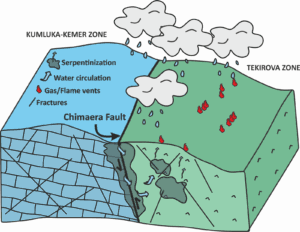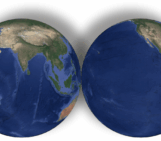
Once upon a time in Lycia there was a land of fire, which burned so bright the light was visible by sailors navigating on the Mare Lycium, who were using the fires as a natural lighthouse.
Mount Chimaera in the country of Phaselis is on fire, and indeed burns with a flame that does not die by day or night
Those were the words of Pliny the Elder in his Naturalis Historia (2.110).
Ancient Lycia is nowadays known as the Antalya province, located in Southwestern Anatolia (Turkey), where the Mount Chimaera, at the site called Yanartaş, is still “on fire”. The presence of fire pits represents both a rare geological event, and the base of a myth about a powerful and fearsome creature, the Chimaera.
The Chimaera: three animals in one creature

Fig. 1. Etruscan Chimera of Arezzo, National Archeological Museum, Florence (Italy).
The Chimaera (Fig. 1) was a fire-breathing she-monster with a lion’s head and body in her forepart, a goat’s head and body in her middle and a dragon-like body with a serpent’s tail in her hind part (Homer, Iliad, scroll 6); the mythical creature joined the abilities of three animals in one, making her incredibly fierce and powerful. According to Hesiod (Theogony, 319), the Chimaera had divine origins, born from her mother Echidna, half nymph and half snake with speckled skin, and her father Typhoeus, a terrible, outrageous, lawless strong god from whose shoulder grew hundred of snakes’ heads (Hesiod, Theogony, 820). In addition, she was the sister of the infamous Cerberus and Hydra, among other monsters.
The myth tells how the Chimaera was terrifying the entire region of Lycia, until the hero Bellerophon appeared. Bellerophon, forced to leave from his hometown of Corinth for murdering a man called Bellerus, sought refuge in Argos. There, he was tricked by the Queen Anteia, who wanted him to lie with her in secret, but he was a respectful man of honour and refused. In retaliation to his refusal, Anteia “confessed” to her husband, king Proteus of Argos accusing Bellerophon. The king was unwilling to execute the hero, so instead banished him to Lycia, to the chagrin of the Lobates, King of Lycia, who also did not want to kill Bellerophon while he was his guest. The king of Lycia didn’t know what to do with Bellerophon but eventually Lobates decided to send the hero to perform three dangerous tasks, hoping at least one would be fatal. Among three, Bellerophon had to kill the Chimaera. To have a better chance at killing the monster, Bellerophon bridled Pegasus, the winged white divine horse, and headed to the Chimaera’s whereabouts. Bellerophon then overcame the Chimaera by riddling her with arrows and by flying above her on Pegasus’ back, pointing to her fire-breathing throat with his spear, on whose tip he fixed a lump of lead (Fig. 2).

Fig. 2. Bellerophon riding Pegasus and slaying the Chimera. Central medallion of a Roman mosaic, 2nd to 3rd century CE. Musée Rolin, Autun (France).
The Chimaera retaliated by breathing fire but in the process, melting the lead. The now molten lead coated her insides killing the Chimaera (Graves, 1960). However, being an indestructible creature, the Chimaera’s fire-tongue remained forever burning at the place of her defeat (Piccardi and Balmasse, 2007), the nowadays Yanartaş site in Turkey.
The fires of Mount Chimaera
The Yanartaş (“Flaming rock” in Turkish) site on Mount Chimaera, located in the SW Antalya Province of Turkey, hosts around 50 gas vents, 20 of which, burn with flames as high as ca. 70 cm, distributed in a 5000 km2 wide ophiolite (AGU Blogosphere) outcrop (Fig. 3).
The area is characterized by the presence of the Chimaera Fault (Fig. 3), whose activity started in the Eocene as a thrust fault. It was subsequently reactivated by SSW-dipping strike-slip faults between the late Miocene and early Pliocene, and reworked by a final extensional phase during the late Pliocene. The Chimaera fault represents a sharp contact between the western Kumluka-Kemer Zone, composed of Paleo-Mesozoic sedimentary rocks, and the eastern Cretaceous ophiolite of the Tekirova Zone. The latter hosts the gas vents (Fig. 3b). The gas vents mainly occur close to the Chimaera Fault and several of them are linearly aligned along fractures (Zwicker et al., 2018 and references therein).

Fig. 3. Geological maps showing the main geological units characterizing the SW Antalya Province. Redrawn after Hosgörmez, (2007) and Zwicker et al., (2018).
The gas vents and flames emits between 160–190 t/yr of Methane (CH4) and about 3.6 t/yr of Hydrogen (H2); however, the inflammable CH4 flux is also released by diffuse exhalation through the area (Etiope, 2023), as also already observed by Pliny the Elder (Naturalis Historia, 2.110):
In the same country of Lycia, the mountains of Hephæstius, when touched with a flaming torch, burn so violently, that even the stones in the river and the sand burn… this fire is also increased by rain

Fig. 4. Schematic sketch, showing the structural framework and the gas vents distribution close to the Chimaera Fault. Redrawn after Hosgörmez (2007).
The origins of both gases has been inferred to be abiogenic, even if a smaller biogenic component as been suggested for the production of the CH4. Their formation is driven by a slow and low temperature serpentinization of the Tekirova ophiolite at depth, mainly driven by the subsurface water circulation containing dissolved Carbon Dioxide (CO2), which initiate serpentinization (Fig. 4). The long-lasting gas emissions are suggested to be related to the pressurized source of serpentinization at depth (Etiope, 2023; Hosgörmez, 2007; Zwicker et al., 2018).
References
Hesiod, The Homeric Hymns and Homerica with an English Translation by Hugh G. Evelyn-White. Theogony. Cambridge, MA., Harvard University Press; London, William Heinemann Ltd. 1914. http://data.perseus.org/citations/urn:cts:greekLit:tlg0020.tlg001.perseus-eng1:337-370. Last visit on 03.03.2024.
Homer, The Iliad. Samuel Butler, Ed. https://www.perseus.tufts.edu/hopper/text?doc=Hom.+Il.+6.6. Last visit on 03.03.2024.
Pliny the Elder, The Natural History. John Bostock, M.D., F.R.S. H.T. Riley, Esq., B.A. London. Taylor and Francis, Red Lion Court, Fleet Street. 1855. http://data.perseus.org/citations/urn:cts:latinLit:phi0978.phi001.perseus-eng1:2.110. Last visit on 03.03.2024.
AGU Blogosphere. https://blogs.agu.org/georneys/2011/02/10/geology-word-of-the-week-o-is-for-ophiolite/. Last visit on 03.03.2024.
Piccardi, L., Balmasse, W.B., 2007. Myth and Geology. Geological Society, London, Special publication 273.
Graves, R., 1960. The Greek Myths. Penguin Books, London.
Etiope, G., 2023. Massive release of natural hydrogen from a geological seep (Chimaera, Turkey): Gas advection as a proxy of subsurface gas migration and pressurized accumulations. International Journal of Hydrogen Energy 48, 9172–9184, doi: https://doi.org/10.1016/j.ijhydene.2022.12.025.
Zwicker, J., Birgel, D., Bach, W., Richoz, S., Smrzka, D., Grasemann, B., Gier, S., Schleper, C., Rittmann, S.K.-M.R., Koşun, E., Peckmann, J., 2018. Evidence for archaeal methanogenesis within veins at the onshore serpentinite-hosted Chimaera seeps, Turkey. Chemical Geology 483, 567–580, doi: https://doi.org/10.1016/j.chemgeo.2018.03.027.
Hosgörmez, H., 2007. Origin of the natural gas seep of Çirali (Chimera), Turkey: Site of the first Olympic fire. Journal of Asian Earth Sciences 30, 131–141. https://doi.org/10.1016/j.jseaes.2006.08.002.




